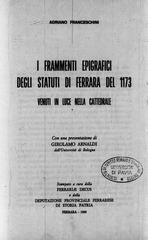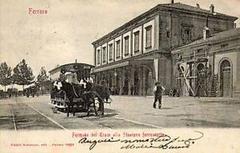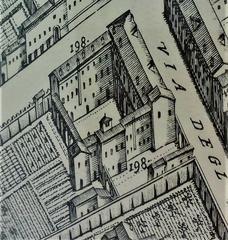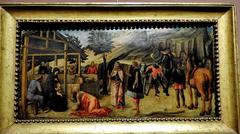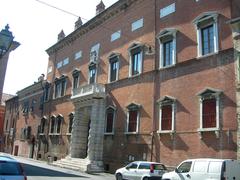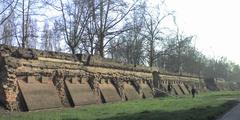Castello Estense Visiting Hours, Tickets, and Ferrara Historical Sites Guide
Date: 14/06/2025
Introduction to Castello Estense and Its Historical Significance
In the heart of Ferrara, Italy, the Castello Estense stands as an enduring symbol of the city’s transformation from medieval stronghold to Renaissance cultural epicenter. Commissioned in 1385 by Marquis Niccolò II d’Este in response to civic unrest, this iconic castle evolved from fortress to lavish ducal residence. Today, Castello Estense is celebrated for its robust towers, scenic moat, elegant Renaissance interiors, and its pivotal role in Ferrara’s designation as a UNESCO World Heritage Site. This guide provides a comprehensive overview for visitors—covering essential historical context, architectural highlights, visiting hours, ticketing, accessibility, and tips for exploring Ferrara’s many historical attractions. (Inferrara, ItalyScapes, Ferrara Terra e Acqua)
Table of Contents
- Introduction
- Historical Overview: 1385 to 19th Century
- Architectural Features & Symbolism
- Visiting Information: Hours, Tickets, and Accessibility
- Exploring the Castle: Courtyard, Interiors, and Towers
- Guided Tours and Educational Programs
- Nearby Attractions and Travel Tips
- Special Events and Restoration Initiatives
- Frequently Asked Questions (FAQ)
- Conclusion and Visitor Resources
Historical Overview: From Fortress to Renaissance Palace
Origins and Construction (1385–15th Century)
The Castello Estense was commissioned on May 3, 1385, after a violent revolt in Ferrara. Designed by Bartolino da Novara, the fortress featured a square plan with four imposing towers and a moat fed by the Po River. The original construction incorporated the Torre dei Leoni (a pre-existing watchtower) and was connected to the Este family’s palace via the covered “Via Coperta,” ensuring the rulers’ safety during times of unrest. (Wikipedia, ItalyScapes, Inferrara)
Renaissance Transformation (15th–16th Centuries)
As the Este dynasty ascended to greater cultural and political prominence, the castle underwent significant expansion. Successive dukes, especially during the “Addizione Erculea” urban renewal under Ercole I d’Este, transformed the fortress into a sumptuous residence. Lavish loggias, marble balconies, frescoed halls, and the elegant Orange Garden (Giardino degli Aranci) were added, reflecting the family’s patronage of the arts and their role in making Ferrara a leading Renaissance center. (Spuntidiviaggio)
Intrigue, Drama, and Political Power
Castello Estense’s dungeons are infamous for their stories of intrigue—most notably, the decades-long imprisonment of Giulio d’Este after a failed conspiracy, and the execution of lovers Ugo and Parisina Malatesta in 1425. Courtly life flourished in the upper halls, where banquets, artistic performances, and political negotiations took place under the Este’s watchful eye. (Inferrara)
Later History: Papal Rule and Modern Use
Following the end of Este rule in 1598, the castle became the seat of papal legates. During the 19th and 20th centuries, it served various administrative functions, survived the 2012 earthquake thanks to major restoration, and now stands as a premier museum and cultural venue. (ItalyScapes, Spuntidiviaggio)
Architectural Features & Symbolism
Castello Estense is a masterpiece of the transition from military fortification to Renaissance palace. Its four iconic towers—Torre dei Leoni, Torre Marchesana, Torre di San Paolo, and Torre di Santa Caterina—frame a water-filled moat and are connected by drawbridges. The interiors showcase grand staircases, richly frescoed halls, the Hall of Coats of Arms, Orange Garden loggias, and evocative prison cells. The castle’s red brick exterior and sweeping balustrades are quintessential elements of Ferrara’s urban identity and Renaissance aesthetics. (Inferrara, Spuntidiviaggio)
Visiting Information: Hours, Tickets, and Accessibility
Visiting Hours
Visiting hours vary seasonally:
- April to October: Tuesday–Sunday, 9:00 AM – 7:30 PM (last entry 6:30 PM)
- November to March: Tuesday–Sunday, 10:00 AM – 5:30 PM (last entry 4:30 PM)
- Closed on Mondays
Always check the official site for updates, holiday schedules, or restoration closures.
Ticket Prices
- General Admission: €10
- Reduced Admission (EU citizens 18–25): €7
- Free Entry: EU citizens under 18, Ferrara residents, and other categories (see official website)
- Online Booking: Available and recommended for peak seasons (Comune di Ferrara booking portal)
- MYFE Card: Holders receive free entry and discounts at other Ferrara sites
Accessibility
- Wheelchair Access: Main courtyard, ground-floor museum spaces, and elevators available
- Assistance: Contact ahead for support with mobility needs
- Limitations: Some towers, upper floors, and dungeons may be inaccessible due to historical structures
Exploring the Castle: Courtyard, Interiors, and Towers
Arrival and Entry
Centrally located, Castello Estense is accessible on foot from Ferrara’s train station or city center, with public transport and parking nearby. The dramatic approach—across drawbridges and past the moat—offers excellent photo opportunities, especially at sunrise or sunset. (Ferrara Terra e Acqua)
Courtyard and Public Spaces
The Renaissance courtyard is free to access and serves as a tranquil gathering point for visitors. Ticketed entry leads to the museum, upper floors, and tower climbs. Guided tours typically begin here. (Shego Wandering)
Museum and Exhibits
- Frescoed Halls: Renaissance frescoes depict Este court life and mythological themes
- Art Collections: Paintings, sculpture, and decorative arts from the Este era
- Historical Artifacts: Documents, armor, and multimedia displays detail the castle’s evolution
- Ducal Chapel: Reflects the religious and political shifts of the Este court
Tower Climb: Torre dei Leoni
Climb the Torre dei Leoni for panoramic views of Ferrara’s medieval streets and countryside—a highlight for many visitors. The ascent is moderately challenging but rewarding. (Ferrara Terra e Acqua)
Guided Tours and Educational Programs
- Guided Tours: Available in Italian, English, and other languages; highly recommended for historical context
- Audio Guides: Offered in multiple languages for self-guided exploration
- Educational Programs: Interactive exhibits and activities, especially during festivals and special exhibitions (The Tourist Checklist)
Nearby Attractions and Travel Tips
Castello Estense anchors Ferrara’s UNESCO-listed historic center. Within walking distance:
- Ferrara Cathedral (Duomo): Romanesque and Gothic masterpiece
- Palazzo dei Diamanti: Noted for its unique façade and art exhibitions
- Rotonda Foschini: Elegant elliptical courtyard
- Corso Ercole I d’Este: Iconic Renaissance boulevard
Travel Tips:
- Visit in spring or autumn for mild weather and fewer crowds
- Allow at least two hours for the castle, plus time for exploring nearby attractions
- Many local restaurants and shops are located just outside the castle walls
Special Events and Restoration Initiatives
Castello Estense hosts art exhibitions, concerts, educational workshops, and Renaissance-themed festivals. Beginning June 2025, a €3 million restoration will focus on seismic upgrades and museum enhancements. During works, special initiatives like “Off Inside – Live Outside” and “Oltre il Castello” will keep the castle’s cultural presence active. (La Nuova Ferrara, Estense.com)
Frequently Asked Questions (FAQ)
Q: What are the Castello Estense visiting hours?
A: Typically Tuesday–Sunday, 9:00–19:30 (April–October) or 10:00–17:30 (November–March); closed Mondays.
Q: How much are Castello Estense tickets?
A: General admission is €10; discounts for students, youth, and free entry for children, residents, and MYFE cardholders.
Q: Is the castle accessible for people with disabilities?
A: The courtyard and main museum spaces are accessible; some towers and historic staircases may not be.
Q: Are guided tours available?
A: Yes, in several languages; advance booking is advised.
Q: Can I take photographs inside the castle?
A: Non-flash photography is permitted in most areas, though some restrictions apply.
Q: What are other must-see sites near Castello Estense?
A: Ferrara Cathedral, Palazzo dei Diamanti, Rotonda Foschini, and the city’s historic walls.
Conclusion and Visitor Resources
Whether you’re passionate about history, art, or simply seeking a unique Italian adventure, Castello Estense will inspire and delight.
References
- Castello Estense, Inferrara
- Castello Estense, ItalyScapes
- Castello Estense Visitor Information, Ferrara Terra e Acqua
- Restoration and Cultural Initiatives at Castello Estense, La Nuova Ferrara
- Castello Estense Restoration Projects, Estense.com
- Spuntidiviaggio
- Shego Wandering
- The Tourist Checklist
- Comune di Ferrara Booking Portal
- Wikipedia
- corvinus.nl
- notyourmamasitaly.com
- visitferrara.eu
- traveltoitalyguide.com
